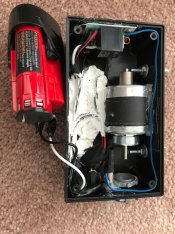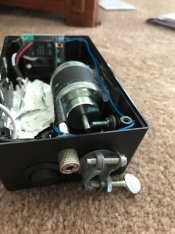brent8927
Member
I built a remote shutter release a number of years ago, but I need to rebuild it and wanted to see if anyone has more wisdom than I do. (And if there isn't, then hopefully this will be helpful for people looking to do the same at some point)
I use a Hasselblad 501c, and originally the idea was to do a wedding photo shoot of my wife and I, (which fortunately turned out great, and obviously was very personable). A bulb release was out of the question as it was visible (and if memory serves me correct, not strong enough to trip the blad's shutter anyway). The small mechanical timer ones you find on ebay never seemed to be strong enough either, successfully tripping the shutter about 10-20% of the time.
My first question is, what others do to trigger a Hasselblad (or other difficult to trip) remotely?
I realize one option is to buy a ELM/D model and use Hasselblad's radio remote release (or IR remote release for the 555), but that requires buying a fairly bulky camera that. The 200 series all have a timer, but that's a lot of money to spend on an old electronic camera for just a timer. I know c lenses do have timers, but my understanding is they're not the greatest, and ideally, I want to avoid a timer altogether anyway.
The purpose of the camera is to shoot portraits of my family (with me in it!). I realize a point and shoot or any old 35mm camera with a timer could be a substitute, but I really want to use this camera. I like the photos it creates, and I like creating photos with it.
The box I made utilizes the following (I do apologize for how messy it looks--I'm an amateur with this stuff, so it's held together with hot glue, gaffer's tape, solder, and for some reason I used caulk to hold the wires down. Safe to say, I won't be bringing this thing on a plane anytime)
- Solenoid (from McMaster-Carr)
- Remote radio release (obtained on ebay)
- Milwaukee M12 Battery (I had taken the black shroud off so it would fit in the box, but that battery recently died). I also purchased the cheapest M12 tool I could find (a flashlight) so I could use the adapter/plug rather than sticking wires into the battery.
- On/off switch (McMaster)
- Some kind of pipe conduit clamp I used to hold the cable release in place
- I had rigged it to accommodate an antenna, but that wasn't necessary after testing
I used a solenoid, rather than a servo, which seemed to be the preferred method, as a servo requires the corkscrew action to trip a shutter release, and thus wasn't that quick (from what others told me). I think re-setting the servo could also be an issue. The solenoid just moves back and forth (hitting the "on" button trigger the electromagnetic field, which causes the piston-like portion to jolt forward, hitting "off" causes it to release, which lets gravity "reset" the piston), so it seemed like a good option.
The M12 battery was necessary because I needed a battery with a higher voltage/amperage and draw current. In my testing one of those large lantern batteries did the trick while no smaller ones did, but that was not portable (too big, too heavy). I figured a Lithium-ion tool battery would be both light and powerful enough, which it was.
Basically, I clamp my standard cable release to the pipe conduit clamp (if anyone knows what this is actually called, please feel free to correct me) and set it to the default/"spring" setting (so it recoils and releases the shutter, rather than lock and hold down the auxiliary shutter). I turn the unit on, and then I hit "on" on the key-fob-sized remote release to take the photo, and the piston jolts forward to compress the cable release. This does it somewhat strongly, since as I mentioned, a Hasselblad is hard to trip. The cable release seems to absorb some impact by flexing a bit. The photo is taken very quickly--not quite instantaneously, but close. Then I just run over to the camera, advance the frame, and run back.
Areas I'm hoping to improve:
1) I'd like to try out some smaller/weaker solenoids, but I tried quite a few out and this may be the weakest one that works. Does anyone know if it's actually possible to trip the shutter "too strong" and damage the camera? It hasn't caused an issue with the roughly 50-60 shots I've taken.
2) I'd be curious to know if others used a different system altogether (using a servo instead), and how that works (speed, etc.)
3) I really think my clamping system to attach the cable release is subpar and it looks rather ugly--any ideas on a better system?
You're welcome to ask me any questions you have about how I manufactured the unit, in case anyone would like to make something similar.
I use a Hasselblad 501c, and originally the idea was to do a wedding photo shoot of my wife and I, (which fortunately turned out great, and obviously was very personable). A bulb release was out of the question as it was visible (and if memory serves me correct, not strong enough to trip the blad's shutter anyway). The small mechanical timer ones you find on ebay never seemed to be strong enough either, successfully tripping the shutter about 10-20% of the time.
My first question is, what others do to trigger a Hasselblad (or other difficult to trip) remotely?
I realize one option is to buy a ELM/D model and use Hasselblad's radio remote release (or IR remote release for the 555), but that requires buying a fairly bulky camera that. The 200 series all have a timer, but that's a lot of money to spend on an old electronic camera for just a timer. I know c lenses do have timers, but my understanding is they're not the greatest, and ideally, I want to avoid a timer altogether anyway.
The purpose of the camera is to shoot portraits of my family (with me in it!). I realize a point and shoot or any old 35mm camera with a timer could be a substitute, but I really want to use this camera. I like the photos it creates, and I like creating photos with it.
The box I made utilizes the following (I do apologize for how messy it looks--I'm an amateur with this stuff, so it's held together with hot glue, gaffer's tape, solder, and for some reason I used caulk to hold the wires down. Safe to say, I won't be bringing this thing on a plane anytime)
- Solenoid (from McMaster-Carr)
- Remote radio release (obtained on ebay)
- Milwaukee M12 Battery (I had taken the black shroud off so it would fit in the box, but that battery recently died). I also purchased the cheapest M12 tool I could find (a flashlight) so I could use the adapter/plug rather than sticking wires into the battery.
- On/off switch (McMaster)
- Some kind of pipe conduit clamp I used to hold the cable release in place
- I had rigged it to accommodate an antenna, but that wasn't necessary after testing
I used a solenoid, rather than a servo, which seemed to be the preferred method, as a servo requires the corkscrew action to trip a shutter release, and thus wasn't that quick (from what others told me). I think re-setting the servo could also be an issue. The solenoid just moves back and forth (hitting the "on" button trigger the electromagnetic field, which causes the piston-like portion to jolt forward, hitting "off" causes it to release, which lets gravity "reset" the piston), so it seemed like a good option.
The M12 battery was necessary because I needed a battery with a higher voltage/amperage and draw current. In my testing one of those large lantern batteries did the trick while no smaller ones did, but that was not portable (too big, too heavy). I figured a Lithium-ion tool battery would be both light and powerful enough, which it was.
Basically, I clamp my standard cable release to the pipe conduit clamp (if anyone knows what this is actually called, please feel free to correct me) and set it to the default/"spring" setting (so it recoils and releases the shutter, rather than lock and hold down the auxiliary shutter). I turn the unit on, and then I hit "on" on the key-fob-sized remote release to take the photo, and the piston jolts forward to compress the cable release. This does it somewhat strongly, since as I mentioned, a Hasselblad is hard to trip. The cable release seems to absorb some impact by flexing a bit. The photo is taken very quickly--not quite instantaneously, but close. Then I just run over to the camera, advance the frame, and run back.
Areas I'm hoping to improve:
1) I'd like to try out some smaller/weaker solenoids, but I tried quite a few out and this may be the weakest one that works. Does anyone know if it's actually possible to trip the shutter "too strong" and damage the camera? It hasn't caused an issue with the roughly 50-60 shots I've taken.
2) I'd be curious to know if others used a different system altogether (using a servo instead), and how that works (speed, etc.)
3) I really think my clamping system to attach the cable release is subpar and it looks rather ugly--any ideas on a better system?
You're welcome to ask me any questions you have about how I manufactured the unit, in case anyone would like to make something similar.












